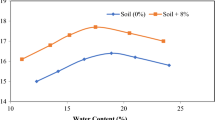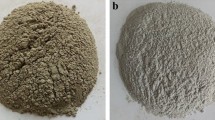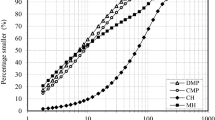Abstract
The engineering properties of soils are considerably affected by freeze and thaw cycles in colder regions. Repeated cycles of freeze and thaw reduce the strength of soil by damaging soil structure. Therefore, soil subjected to frost action shows settlement and reduction in compressive strength. In this research work, the variation in the compressive strength with the freeze-thaw cycle is evaluated and improved by using terrazyme. The present research work investigated its usage for ground improvement. Samples of silty clays were extracted from two sites in Pakistan, i.e., Murree and Shangla, due to their unique climate resulting from high elevation and cold temperature. After performing a series of tests, it was observed that after seven cycles of freeze and thaw, the strength of Murree and Shangla soils reduced by 82% and 61% respectively in an untreated condition. Optimization of terrazyme showed that the maximum amount of terrazyme for Murree and Shangla should be 0.015 ml and 0.017 ml respectively. An increase of 36% in unconfined compressive strength for Murree soil and 18% in Shangla soil was observed with the addition of bio-enzyme. A considerable reduction in the moisture content was observed, along with a significant increase in the compressive strength of the soil.












Similar content being viewed by others
References
ASTM, D (2006) Standard test method for unconfined compressive strength of cohesive soil. ASTM standard D, p 2166
Bergmann R (2000) "Soil stabilizers on universally accessible trails. Study Results, United States Department of Agriculture"
Calvo MAA (2009) Bio-enzyme stabilized lateritic soil as a highway material. In: Journal of the Indian Roads Congress
Chamberlain EJ, Gow AJ (1979) Effect of freezing and thawing on the permeability and structure of soils. In: Developments in Geotechnical Engineering. Elsevier
Changizi F, Ghasemzadeh H, Ahmadi S (2022) Evaluation of strength properties of clay treated by nano-SiO2 subjected to freeze–thaw cycles. Road Mater Pavement Des 23:1221–1238
Chen Z-J, Li M, Yuan Li LX, Zhao RT, Sheng Y, Gao X, Chang CH, Feng HL (2004) Effects of sucrose concentration on the developmental potential of human frozen–thawed oocytes at different stages of maturity. Hum Reprod 19:2345–2349
Dandin, Shahbaz, and Santosh Hiremath (2014) 'A study on some geotechnical properties of bio-enzyme stabilized expansive soil'
Divya V, Asha MN (2021) Investigations on mechanical properties of bio-stabilized soil. In: Ground Improvement Techniques. Springer
Eigenbrod KD, Knutsson S, Sheng D (1996) Pore-water pressures in freezing and thawing fine-grained soils. J Cold Reg Eng 10:77–92
Eu**e GN, Somervell LT, Chandrakaran S, Sankar N (2014) Enzyme stabilization of high liquid limit clay. Electron J Geotech Eng 19:6989–6995
Fatehi H, Ong DEL, Jimmy Y, Chang I (2021) Biopolymers as green binders for soil improvement in geotechnical applications: a review. Geosciences 11:291
Firoozi AA, Taha MR, Firoozi AA, Khan TA (2015) The influence of freeze-thaw cycles on unconfined compressive strength of clay soils treated with lime. J Teknol 76
Gowthaman S, Nakashima K, Kawasaki S (2020) Freeze-thaw durability and shear responses of cemented slope soil treated by microbial induced carbonate precipitation. Soils Found 60:840–855
Gupta A, Saxena V, Saxena A, Salman M, Aarfin S, Kumar A (2017) Review paper on soil stabilization by terrazyme. Int J Res Eng Technol 7:54–57
Konrad J-M (1989) Physical processes during freeze-thaw cycles in clayey silts. Cold Reg Sci Technol 16:291–303
Lacuoture A, Gonzalez H (1995) Usage of organic enzymes for the stabilization of natural base soils and sub-bases in Bagota. Pontificia Universidad Jevariana, Faculty of Engineering
Marathe S, Shankar AU (2021) Investigations on bio-enzyme stabilized pavement subgrades of lateritic, lithomargic and blended soils. Int J Pavement Res Technol:1–11
Meeravali K, Alla S, Syed H, Ruben N (2020) An analysis of freeze-thaw cycles on geotechnical properties of soft-soil. Mater Today: Proc 27:1304–1309
Muguda S, Nagaraj HB (2019) Effect of enzymes on plasticity and strength characteristics of an earthen construction material. Int J Geotech Eng 10:1–14
Nature Plus, United States (2004) 'Terrazyme as a soil stabilizer'
Navale, Aniket S, Rushikesh S Kanawade, Umesh C Hase, and Amol S Pansare (2019) 'Effect of bio-enzyme (Terrazyme) on the properties of sub grade soil'
Norris R, Ryan L, Acaster D (2011) Cambridge international AS and A level chemistry coursebook. (Cambridge University Press)
Omoregie AI (2020) A feasible scale-up production of Sporosarcina pasteurii using custom-built stirred tank reactor for in-situ soil biocementation. Biocatal Agric Biotechnol 24:101544
Omoregie AI, Palombo EA, Ong DEL, Nissom PM (2019) Biocementation of sand by Sporosarcina pasteurii strain and technical-grade cementation reagents through surface percolation treatment method. Construct Build Mater 228:116828
Othman MA, Benson CH (1993) Effect of freeze–thaw on the hydraulic conductivity and morphology of compacted clay. Can Geotech J 30:236–246
Pooni J, Giustozzi F, Robert D, Setunge S, O'Donnell B (2019) Durability of enzyme stabilized expansive soil in road pavements subjected to moisture degradation. Transport Geotech 21:100255
Scholen DE (1995) Stabilizer mechanisms in nonstandard stabilizers. In: Transportation research board conference proceedings
Shukla, Manoj, Sunil Bose, and PK Sikdar (2003) 'Bio-enzyme for stabilization of soil in road construction a cost effective approach'
Soil, ASTM Committee D-18 on, and Rock (2009) Standard Test Methods for Laboratory Compaction Characteristics of Soil Using Modified Effort (56,000 Ft-Lbf/Ft3 (2,700 KN-M/M3)) 1. ASTM international
Standard ASTM (2016) Standard test methods for freezing and thawing compacted soil-cement mixtures. ASTM Int West Conshohocken, PA
Steiner A, Vardon PJ, Broere W (2018) The influence of freeze–thaw cycles on the shear strength of illite clay. Proc Inst Civ Eng Geotech Eng 171:16–27
Viklander P (1997) Compaction and thaw deformation of frozen soil: permeability and structural effects due to freezing and thawing. Luleå tekniska universitet
Wei C, Sheng Y, Jichun W, Yaling C, Erxing P, Leonid G (2021) Soil hydrological process and migration mode influenced by the freeze-thaw process in the activity layer of permafrost regions in Qinghai-Tibet Plateau. Cold Reg Sci Technol 184:103236
**e S-b, Jian-Jun Q, Yuan-Ming L, Zhi-Wei Z, **ang-Tian X (2015) Effects of freeze-thaw cycles on soil mechanical and physical properties in the Qinghai-Tibet Plateau. J Mt Sci 12:999–1009
Yusoff SA, Mohd N, Azmi M, Ramli H, Bakar I, Wijeyesekera DC, Zainorabidin A (2017) Laboratory investigation of TerraZyme as a soil stabilizer. In: AIP Conference Proceedings, 030014. AIP Publishing LLC
Zeinali A, Dagli D, Edeskär T (2016) Freezing-thawing laboratory testing of frost susceptible soils. In: Nordic Geotechnical Meeting: Challanges in Nordic Geotechnics 25/05/2016-27/05/2016, pp 267–276
Zha F, Qiao B, Kang B, Long X, Chu C, Yang C (2021) Engineering properties of expansive soil stabilized by physically amended titanium gypsum. Construct Build Mater 303:124456
Zhang DS, Wang (2001) Mechanism of freeze–thaw action in the process of soil salinization in northeast China. Environ Geol 41:96–100
Author information
Authors and Affiliations
Corresponding author
Ethics declarations
Conflict of interest
The authors declare no competing interests.
Additional information
Responsible Editor: Zeynal Abiddin Erguler
Rights and permissions
Springer Nature or its licensor (e.g. a society or other partner) holds exclusive rights to this article under a publishing agreement with the author(s) or other rightsholder(s); author self-archiving of the accepted manuscript version of this article is solely governed by the terms of such publishing agreement and applicable law.
About this article
Cite this article
Waleed, M., Liaqat, N., Jamil, M.AB. et al. Unconfined compressive strength and freeze-thaw behavior of silty clay soils treated with bio-enzyme. Arab J Geosci 16, 275 (2023). https://doi.org/10.1007/s12517-023-11375-4
Received:
Accepted:
Published:
DOI: https://doi.org/10.1007/s12517-023-11375-4




